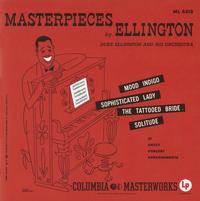Duke Ellington - Masterpieces By Ellington
| Label: |
Analogue Productions |
| Genre: |
Jazz |
| Product No.: |
CAPJ 4418 SA
|
| UPC: | 753088441868 |
| Availability: |
In Stock
|
| Category: |
Hybrid Mono SACD |
A historic record — recorded just four years removed from the dawn of the analog tape era!
Remastered by Ryan Smith at Sterling Sound from the original analog tapes
Recorded originally on an Ampex 200, using 3M-111 magnetic tape running at 15 inches per second
Note: The Bonus Tracks presented here were recorded with additional personnel at subsequent sessions
"Even if you have no interest in the music — and I would worry about one who doesn't at the very least respect Duke Ellington — the fact that this mono, 65-year-old recording sounds as lush as it does is reason to investigate. This is subtlety to marvel at, with textures that can only be described as 'ethereal' or 'gossamer-like.' Offering the original selection of uncut concert arrangements from 1950 of 'Mood Indigo,' 'Sophisticated Lady,' 'The Tattooed Bride,' and 'Solitude,' it has been expanded by 'Vagabonds,' 'Smada' and 'Rock Slippin' At The Blue Note,' from 1951. Ellington's first LP for Columbia, this release helped to establish the concept of an 'album.'" — Sound Quality = 88% - Ken Kessler, HiFi News, January 2016
"...the SACD has much vaster dynamic range, on the soft and loud ends of the spectrum. It's clear, after listening to the two back-to-back, that the Columbia CD was compressed. Not heavily: before hearing the LP and now the SACD, I wouldn't have guessed it was compressed at all; the superb Mark Wilder, who mastered that edition in DSD, has a subtle touch. But for lifelike dynamics, the real sound of the horns, bass, and drums especially, spend the extra $22.50." — Fred Kaplan, Stereophile, Jan. 26, 2015 Read the whole review here.
Praise for the Analogue Productions LP version of Masterpieces:
"Most highly recommended (the record is now on the QRP presses). It's one of my 'Records to Die For' in the February 2015 Stereophile. You won't have to die to get a copy. $30 will do and it's well worth the money. A true classic both musically and sonically and a historical work of art you can now own." — Music = 11/11; Sound = 11/11 — Michael Fremer, AnalogPlanet.com. Read the whole review here.
"The best album ever made by Duke Ellington, which is to say, one of the best albums in jazz — is also one of his least known. ... now, a leading audiophile record label, Analogue Productions of Salina, Kansas, has brought it out on pristine vinyl (it’s also, despite its vintage, one of the best-sounding jazz albums ever), and the time has come to take notice. ... the new, remastered Analogue Productions LP, which is to the CD as a high-def television is to a circa-1980 Trinitron. Played on a good sound system, it’s a sonic time machine, hurling you into Columbia’s 30th Street Studio with the Ellington orchestra. Horns sound brassy, drums smack, cymbals sizzle, you hear the air pass through the woodwinds. When saxophones play in harmony, the overtones bloom like a sonic bouquet; when the musicians take a quarter-note pause, you hear them breathe in." — Fred Kaplan, Slate, Dec. 9, 2014 Read the whole review here.
"Mood Indigo," "Sophisticated Lady," "The Tattooed Bride" and "Solitude" recorded at Columbia's 30th Street Studio on Dec. 19, 1950.
Masterpieces By Ellington shines from an astonishingly brief period of history that gave the recording industry two of its greatest achievements — the introduction of magnetic tape recording and the 33 1/3 LP, or long-playing record.
Four years. That's all it took to go from the discovery by Americans, of German advancements in the field of sound recording, to the marketing of tape decks in the U.S. by the Ampex company, to Columbia's unveiling of its 12” LP, and the first long-playing record to be sold to consumers.
The four selections contained here catapulted the Maestro Ellington into the LP era, as the great composer/arranger/pianist and his matchless orchestra took full advantage of the possibilities afforded by magnetic tape recording and the still-new 33 1/3 RPM LP to, for the first time, capture uncut concert arrangements of their signature songs.
Duke was joined for the four originally recorded tracks by a virtuoso supporting cast: Duke Ellington, Billy Strayhorn (piano). Russell Procope, Paul Gonzalves, Johnnie Hodges, Jimmy Hamilton (saxophone). Nelson Williams, Andrew Ford, Harold Baker, Ray Nance, William Anderson (trumpet). Quentin Jackson, Lawrence Brown, Tyree Glenn (trombone). Mercer Ellington (horn). Sonny Greer (drums). Wendell Marshall (bass). Yvonne Lanauze (vocals).
BONUS TRACKS: On "Vagabonds" the personnel is Francis Williams, Harold Baker, Willie Cook, Clark Terry, Ray Nance (trumpet). Quentin Jackson, Britt Woodman and Juan Tizol (trombones). Willie Smith, Russell Procope. Jimmy Hamilton, Paul Gonsalves, Harry Carney (saxophone and clarinet). Duke Ellington, piano. Wendell Marshall (bass) Louie Bellson (drums). Recorded at Columbia's 30th Street Studio on Dec. 11, 1951.
On "Smada" and "Rock Skippin' At The Blue Note" the personnel is Nelson Williams, Harold Baker, Ray Nance, Andrew Ford (trumpet). Quentin Jackson, Britt Woodman, Juan Tizol (trombones). Willie Smith (alto sax, soprano sax). Russell Procope (alto sax, clarinet). Jimmy Hamilton (tenor sax, clarinet). Paul Gonsalves (tenor sax). Harry Carney (baritone sax). Billy Strayhorn (piano). Wendell Marshall (bass). Louie Bellson (drums). Recorded at Columbia's 30th Street Studio on Aug. 7, 1951. Note: The reverb heard on these two selections were in the original recordings.
This album wouldn't have been possible without a chain of events starting at the end of World War II. Recorded in December 1950, just five years after Germany fell to the Allies, revealing the Germans' advances in magnetic tape recording, Ellington's master work holds its wonder still today and the recording quality hands-down betters the sound of many modern-day albums.
1944-45: Magnetic tape for sound recording spread to America after an American soldier, Jack Mullin, serving with the U.S. Army Signal Corps in the final months of WW II, received two suitcased-sized AEG 'Magnetophon' high-fidelity recorders and 50 reels of Farben recording tape that had fallen into American hands via the capture of a German radio station at Bad Nauheim. German engineers had perfected the technique of using Alternating Current bias — the addition of an inaudible high-fequency signal (from 40 to 150kHz) — to improve the sound quality of most audio recordings by reducing distortion and noise.
1947: Mullin became an American pioneer in the field of magnetic tape sound recording, after working to modify and improve the machines. He gave two demonstrations of the recorders at Radio Center in Hollywood in October 1947. A later demonstration for singer/entertainer Bing Crosby led to the use of magnetic tape for recording Crosby's radio programs. Crosby became the first star to use tape to pre-record radio broadcasts.
1948: Crosby invested $50,000 in local electronics firm, Ampex, and the tiny six-man concern soon became the world leader in the development of tape recording. Ampex revolutionized the radio and recording industry with its famous Model 200 tape deck, developed directly from Mullin's modified Magnetophones. Units marked serial No. 1 and 2 were delivered in April 1948 in time to record and edit the 27th Bing Crosby show of the 1947-48 season. A 200A at the time retailed for $4,000 — nearly as much as a standard single-family home.
Crosby gave one of the first production tape decks to musician Les Paul, which led to Paul's invention of multitrack recording. The first production model 200A recorders are delivered to ABC and placed in service across the country. This marked the first widespread professional use of magnetic tape recording. Working with Mullin, Ampex rapidly developed 2-track stereo and then 3-track recorders. Mullin and Ampex developed a working monochrome videotape recorder by 1956.
Here's where it gets really interesting, as The Duke and history made matchless audiophile magic. In 1950, two years into the LP era and the transition from disc to magnetic tape recording, Columbia Records got Duke Ellington and his orchestra into the studio to cut a long-playing record. The Columbia 30th Street Studio opened in 1949 and Masterpieces was one of the first recordings done in the studio!
June 1948: Vinyl LPs had taken over as the standard for pressing records by the 1940s; in 1948 Columbia Records introduced its 12-inch Microgroove LP or Long Play record, which could hold at least 20 minutes per side. The first classical long-playing record, and the first 12" LP of any kind— catalog no. Columbia Masterworks Set ML 4001— was Mendelssohn's Concerto in E Minor for Violin and Orchestra, Op. 64, played by violinist Nathan Milstein with the Philharmonic Symphony Orchestra of New York, conducted by Bruno Walter.
December 19, 1950. Masterpieces by Ellington recorded at Columbia's 30th Street Studio. Released in 1951. Recording engineers Fred Plaut and Harold Chapman. Recorded on an Ampex 200, using 3M-111 magnetic tape running at 15 inches per second. (3M-111 tape was also introduced in 1948, the year the Model 200 debuted).
The Columbia 30th Street Studio (CBS 30th Street Studio) nicknamed "The Church" was considered by some to be the best-sounding room in its time and others consider it to have been the greatest recording studio in history. Numerous recordings were made there in all genres, including Miles Davis' Kind of Blue (1959), Leonard Bernstein's West Side Story (Original Cast recording, 1957), Percy Faith's Theme from a Summer Place (1960) and Pink Floyd's The Wall (1979). The facility included both Columbia's "Studio C" and "Studio D."
See historical photos from the heyday of the Columbia 30th Street Studio here.
Columbia Records transformed the former church (the Adams-Parkhurst Memorial Presbyterian Church, dedicated in 1875) into a recording studio in 1949. The studio had 100-foot high ceilings, a 100-foot floorspace to record, and the control room was on the second floor — a tight fit at 8x14 feet. It was later moved to the ground floor.
Suddenly, for the first time in his career, Ellington was able to forgo the 3 minutes-and-change restrictions afforded by the short running time of the 78 RPM disc. He and his band rose to the occasion with extended (11-minute plus) 'uncut concert arrangements' of three of his signature songs — “Mood Indigo,” “Sophisticated Lady,” with evocative vocals by Yvonne Lanauze, as well as “Solitude.” Masterpieces was also notable for the debut of the full-bodied, surprise-laden “The Tattooed Bride,” and for the swansongs of three Ellintonian giants of longstanding: drummer Sonny Greer, trombonist Lawrence Brown and alto saxist Johnny Hodges (the latter two would eventually return to the fold).
Masterpieces is a revelation and a throwback to a golden recording age. So much history and so much luck combined make this album truly special.
"Even in this august company, 'The Tattooed Bride' is a swinging virtuoso piece that, as everyone present must have known, couldn't possibly have been captured in this manner in any era before this session — this was also one of the last sessions to feature the classic Ellington lineup with Johnny Hodges, Lawrence Brown, and Sonny Greer, before their exodus altered the band's sound, and so it's a doubly precious piece (as is the whole album), among the last written specifically for this lineup." — AllMusic.com
| Tracks | 1. Mood Indigo | 2. Sophisticated Lady | 3. The Tattooed Bride | 4. Solitude | Bonus Tracks | 5. Vagabonds | 6. Smada | 7. Rock Slippin’ At The Blue Note |




 (5.00 Stars) 1 person(s) rated this product.
(5.00 Stars) 1 person(s) rated this product. |
|||
|
|||
| Write a review and let people know what you think of this product OR just rate it. | |||
|
View other items by Duke Ellington |
|
 In-Stock Music Orders Over $99 SHIP FREE Within The Continental U.S.
In-Stock Music Orders Over $99 SHIP FREE Within The Continental U.S.







 Login
Login
 My Account
My Account
 Cart
Cart Wishlist
Wishlist
 Contact
Contact





